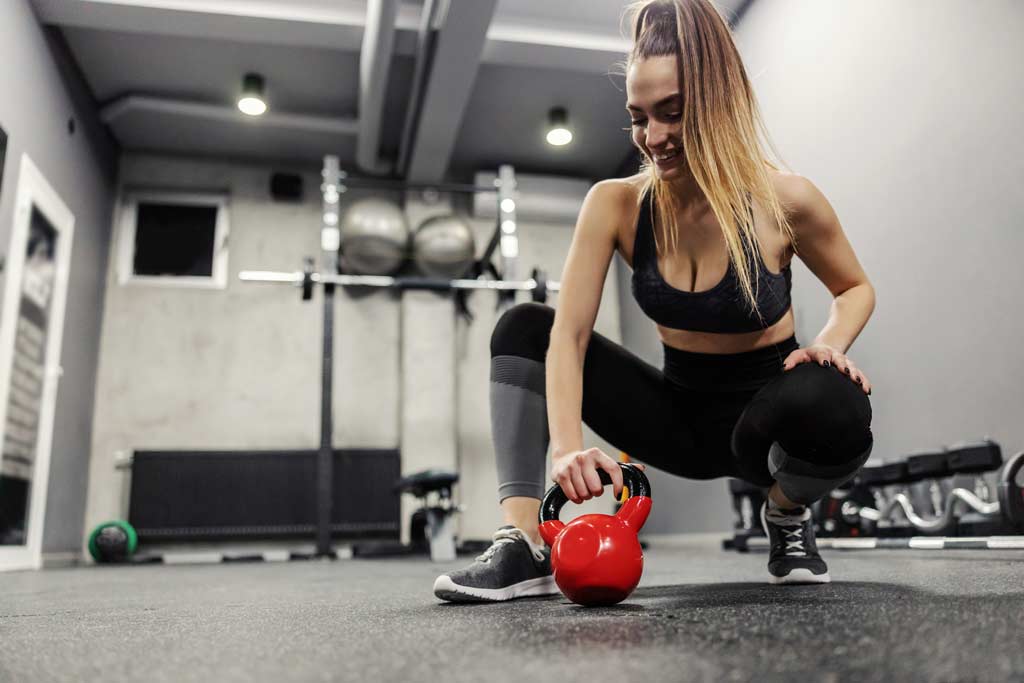When starting kettlebell training, it’s hard to know what weight to get or how many kettlebells you need.
It can be challenging, even intimidating, to begin a home kettlebell practice. You wonder, “How many kettlebells do I need? What weight should those kettlebells be? Can I just get one, or do I need a whole set? And if I get a whole set, should they be different weights or the same?”
How many kettlebells you need will likely change, but to start, the answer is simple: one.
There are exceptions to this, so read on to see if one, two, two adjustable or more kettlebells are best for you.
What is kettlebell training?
Kettlebell training is resistance training (or metabolic resistance training) with kettlebells.
(Argh. I know. That’s annoying.)
So what is a kettlebell? It’s a heavy iron ball with a handle on it. It’s an extremely versatile tool used in strength and metabolic resistance training. Because the weight hangs down, rather than moves in tandem with the hand, it provides constant readjusting of your limbs, core, and entire body as you perform various movements.
Kettlebells are an amazing workout tool. They’re challenging in more ways than one. For one, they provide general resistance, but for another, they open up a world of complex moves that require an almost never-ending quest for perfect coordination.
How kettlebells are different from dumbbells.
Dumbbells are a bar with a weight on either end. The weight’s movement through space is parallel to the hand’s, providing a straightforward tool for building muscle strength and size.
For instance, if you do a curl with a dumbbell, the weight is mostly on the same plane of movement as the hand. It’s a steady weight to provide resistance to your bicep.
The curl performed with a kettlebell, however, is slightly different. The weight hangs down below the hand. Furthermore, as the hand moves upward, the angle of the weight in relation to the hand shifts, meaning the kettlebell handle is turning slightly in the hand. It also changes the angle on the bicep.
Both tools can be used for the curl, but most people find the kettlebell curl more difficult than the dumbbell curl with the same amount of weight. However, more difficult doesn’t mean better. The dumbbell is a better tool for isolating certain muscle groups in a strength– or hypertrophy-focused workout plan.
What kettlebell training looks like.
Kettlebell training can look like whatever you want it to look like. However, kettlebells work best for metabolic conditioning or metabolic resistance training because of their unique ability to use the whole body.
Kettlebells work well with a variety of compound movements that use multiple muscle groups. This naturally gets your heart rate up, providing you with cardiovascular benefits as well as strength training.
And because of the unique shape of the kettlebell, there are also a lot of challenging moves unique to the kettlebell that require practice, agility, and coordination. Some of the most satisfying kettlebell workouts are a combination of moves that flow together. This provides a different approach and focus than a straightforward strength training routine of reps and sets, and even from a standard HIIT or circuit.
So, how many kettlebells do you need?
This post may contain affiliate links. Please see my full disclosure here.
I recommend the following, in order of importance:
- One kettlebell.
- Two kettlebells.
- Two adjustable kettlebells.
Why not just one recommendation? Well, everyone is on their own fitness journey and it’s hard to know what’s right exactly for you at this moment. While one kettlebell is best for most people to start, it depends on a variety of factors, including kettlebell ability, fitness level, type of training preferred, and your other workout equipment.
Why not get an array of kettlebell sizes?
Now, you could purchase a variety of kettlebell sizes. That way you wouldn’t have to worry about which one weight to get.
However, there are some problems with this. For one, it’s extremely expensive. A 35lbs kettlebell will usually cost you close to $100. To get a variety of just three sizes will cost you a few times that. Then, since you want variety, you should probably get each weight as a pair, so you’re buying six kettlebells instead of three. Even if you purchase a set of kettlebells, they rarely come in pairs.
Then there’s the problem of space. Having space for six (or more) kettlebells could be a challenge. And if you’re anything like me, then you may find that having put that much of an effort into the setup means you’re less likely to stick with it.
Why not start with one kettlebell, and build up your inventory as you go?
Why one kettlebell is enough to start.
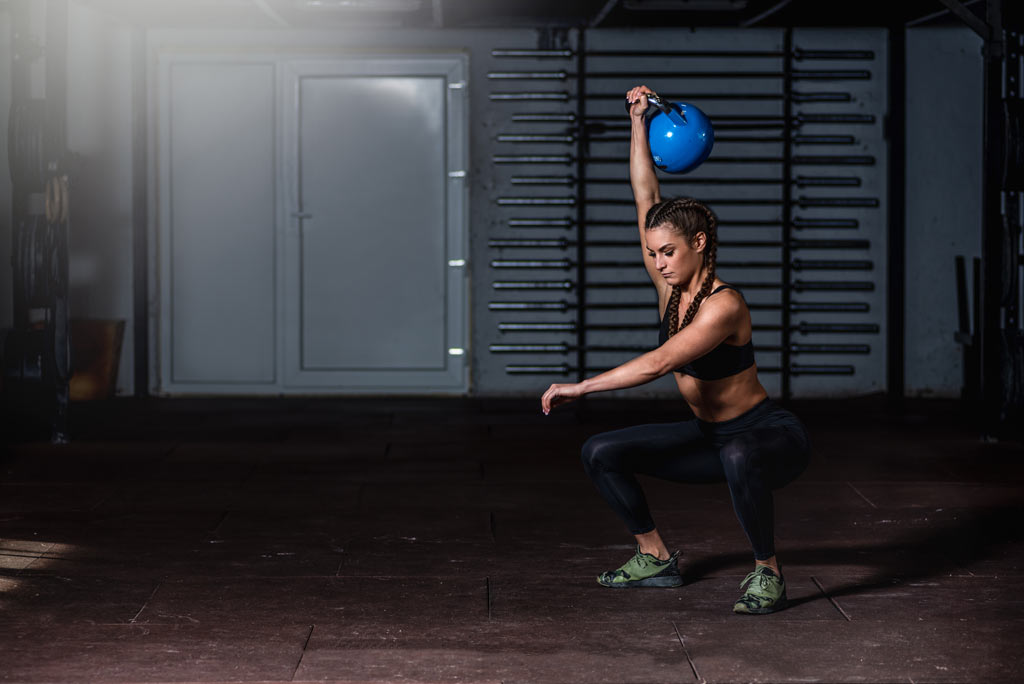
One kettlebell will open up the world of kettlebell strength training to you. If you’ve never tried kettlebell swings, snatches or get-ups, you’ll have a lot of fun exploring these new exercises and developing the strength and coordination for them.
As you get stronger and more confident, you may want or need additional kettlebell weights. However, keep in mind that you can also adjust the difficulty by applying progressive overload [LINK] in various ways. For instance, if 35lbs is too light for swings after a while, try adding more reps, perfecting your form, or trying another swing variation (like single-handed or American).
You can also adjust your workout to the one weight you have. Also, if you’re going for metabolic benefit, then it’s not all about the exact weight.
With one kettlebell, you can explore and learn the following kettlebell exercises:
- Kettlebell swing
- Kettlebell Get-up
- Kettlebell swing high pull
- Kettlebell snatch
- Kettlebell cross-body catch
- Kettlebell clean
- Kettlebell windmill
And in addition to these and many other kettlebell-specific moves, there are traditional free weight exercises you can do with kettlebells, like squats, curls, deadlifts, and so on.
How heavy should your kettlebell be?
How heavy a kettlebell you should obtain depends on your fitness level, your ability with kettlebells, and your specific exercise needs.
Basically, you want a weight that’s heavy enough for your glutes and legs on swings and squats, but also one that you can lift over your head with one arm. If you need help from your lower body to hoist it above, and you can only lift it a few times, that’s fine.
If you are someone who already exercises regularly and has some experience with basic strength training, then I would say get a kettlebell that is a weight that is comfortable for you to do the following (or close to this):
- 20 squats
- 10 overhead presses (single kettlebell, both arms)
- 10 single leg deadlifts
- 10 high pulls (single kettlebell, both arms)
- 5 single-arm thrusters
To be clear, the weight for your one kettlebell should be the one weight with which you could perform the above reps. This amount will be different for everyone, of course, so treat this as a guideline only.
If I were to make a blanket guess, I’d say a 30-35lbs kettlebell would be ideal for an intermediate to experienced fitness enthusiast. 20-25lbs would be good for someone beginner through intermediate, and someone who is a complete beginner would benefit from about 15-18lbs. (Please note that some kettlebells go by pounds, but many have a metric standard and come in kilogram standard weight sizes: 8kg, 10kg, 12kg, 16kg, and so on.)
You don’t want the kettlebell weight to be too heavy so you can’t learn anything. However, you don’t want it to be so easy that you can’t be challenged or grow stronger.
One kettlebell summary:
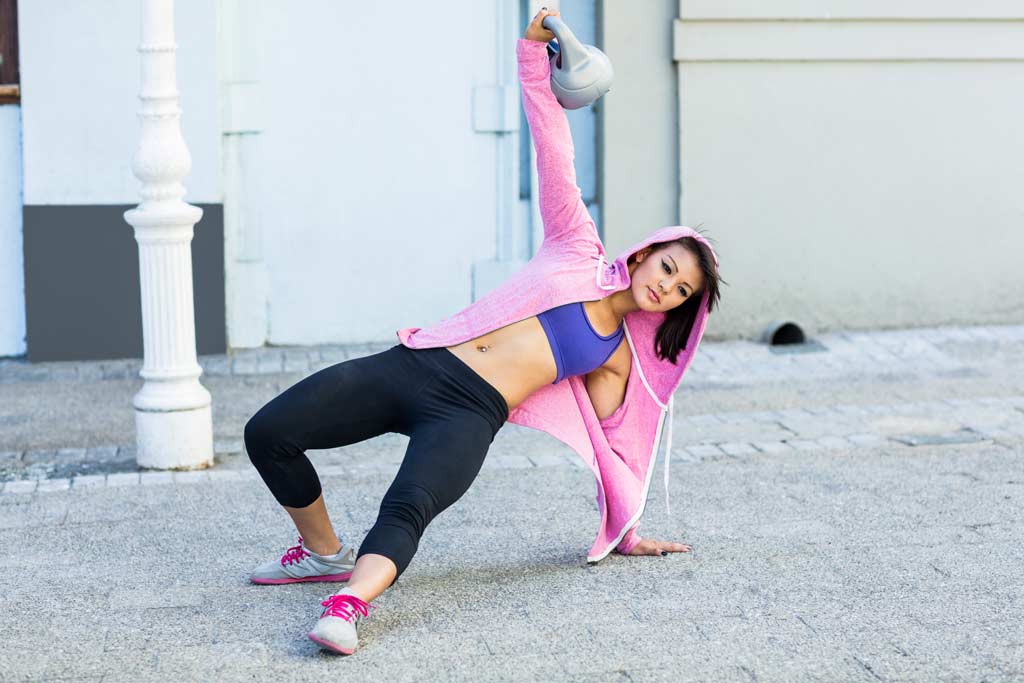
Pros:
- Ability to master one-kettlebell moves
- Simplicity in your workouts
Cons:
- No ability to move up in weight as you grow stronger
- Limited capability with just one weight
Why two kettlebells is also a good idea.
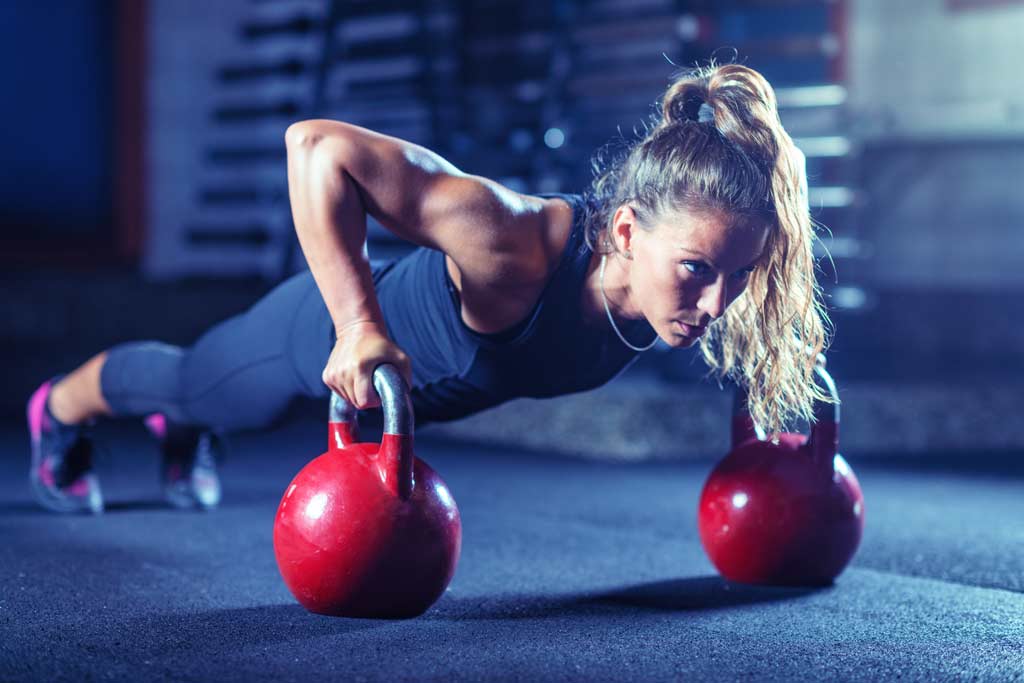
Instead of getting just one kettlebell, some people like to get a pair of kettlebells of the same weight. While this is a viable option, and one that makes perfect sense for dumbbells, it may or may not be the best choice for you.
With two kettlebells, you get the benefit of not one weight set-point, but two. You have the benefit of exercises you can do with just one kettlebell and those that benefit from the weight of both kettlebells.
However, you of course only have the benefit of one kettlebell’s weight for one-kettlebell exercises. This limits your weight limit, while also giving you more options for standard weight lifting exercises.
Some examples of double kettlebell exercises are:
- Double kettlebell clean
- Double kettlebell overhead presses
- Kettlebell thrusters
- Double kettlebell swings
- Kettlebell renegade rows
- Kettlebell bent over rows
While you can still practice and learn one-kettlebell moves like a get-up, for instance, you’ll learn that on the one kettlebell, which is going to be about half the weight (or slightly above) of the weight you would get yourself if you just got the one kettlebell. This might be fine in the beginning, but you might want a heavier weight soon.
How heavy the two kettlebells should be.
Use the same guideline as you would use for one kettlebell, but of course, divide by two. If there is a question of rounding up or down, round up.
For example, if the above exercises are possible but doable with both two 15lbs kettlebells and two 20lbs kettlebells, I suggest getting the 20lbs. If it’s possible but difficult, you can grow into the 20s, whereas you’ll grow out of the 15s pretty fast.
Generally, what should work for most women is two 20lbs kettlebells (or two 25s if there’s no option between 17 and 25) for intermediate to experienced workouters, two 15 to 18lbs kettlebells for intermediates, and two 10lbs kettlebells for beginners.
Remember, this is only a guideline, so go with your knowledge and needs first.
Two kettlebells summary:
Pros:
- More weight variations for simple weight-lifting moves
- A wider array of exercises available
Cons:
- Not able to master or grow with one-kettlebell moves
- More expensive than one kettlebell
Adjustable kettlebells.
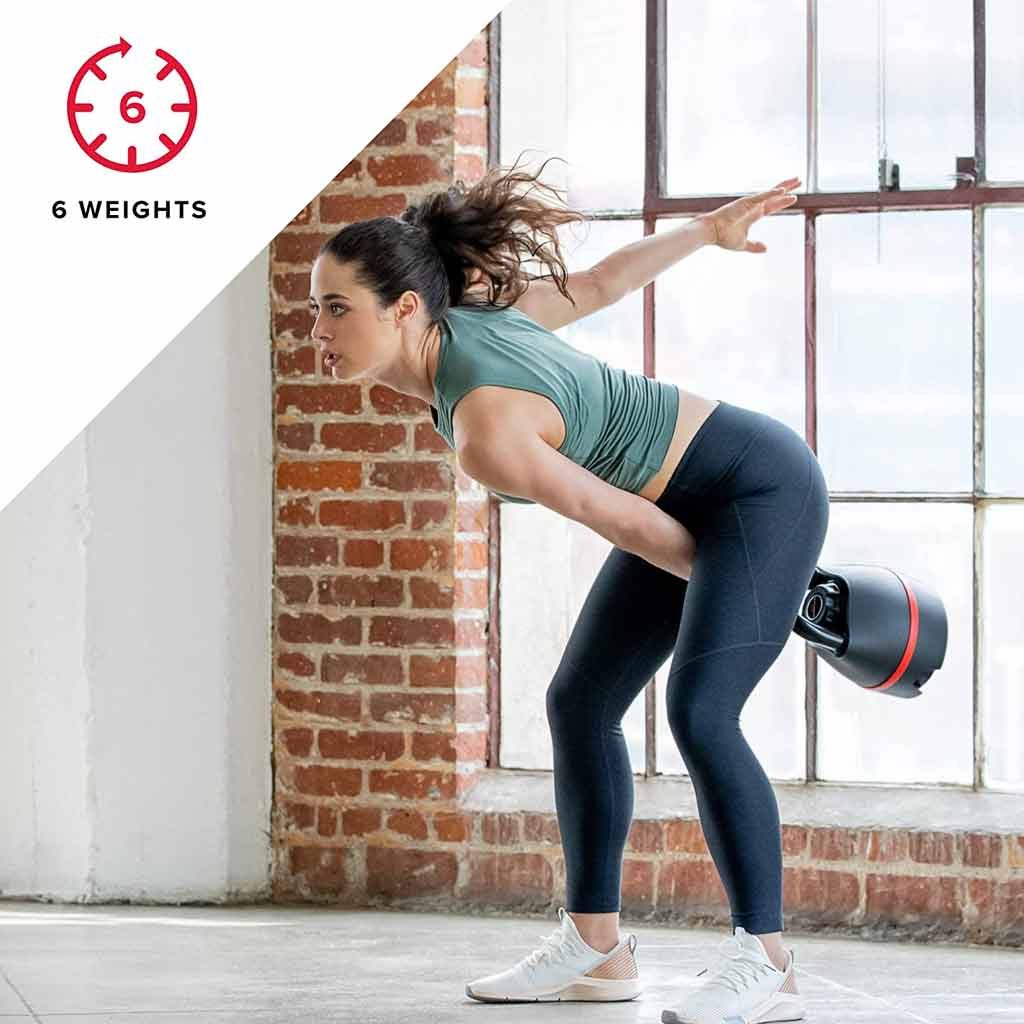
If you don’t want to limit yourself, but still have money and/or space limitations, get two adjustable kettlebells. This is also a fantastic option if you’ve been practicing with one or two kettlebells for a while and need an upgrade. Adjustable kettlebells give you the benefit of having multiple weights available, but save you space and money.
Why not just one adjustable kettlebell?
Why get two adjustable kettlebells, and not just one? Well, if you’re already spending a little bit more for variety, I’d suggest getting two. This will cover your bases as far as being able to do both single-kettlebell and double-kettlebell exercises. It also means you can set them to different weights to use during the workout.
Of course, you can also get one and then get a second at a later time. However, there’s another thing to consider here: adjustable kettlebells aren’t exactly the same as regular kettlebells. They’re not one solid unit, and depending on which brand you get, they might not have weight distributed evenly. You also might not be able to perform the exercises you want because the shape is usually a little different.
If you’re brand new to kettlebells, you should start your training on a standard kettlebell. Adjustable ones are a great space-saving and wallet-saving option, but they’ll always be a notch below.
How heavy should the adjustable kettlebells be?
Adjustable kettlebells come in all weight ranges. You want a range that allows you to grow, so I would highly suggest getting kettlebells that go up to at least 35lbs each with added weight. While you have two kettlebells, since they’re adjustable you’ll want to use them as a pair and as a single kettlebell. 35lbs may sound like a lot, but you’ll need a heavier weight like that for squats and swings, at least once you get stronger.
Keep in mind that some adjustable kettlebells come with a base weight and weight spacers, but not the added weight. The added weight plates you may have to purchase separately. I suggest starting with 5lbs plates. Just be sure to get some that are roughly the size of the kettlebell itself—not too much smaller or wider.
Some adjustable kettlebells, however, come with all the weights you need.
Also, remember that while they are adjustable, it’s a bit tedious to change their size. It’s ideal to set them at one weight for the entire workout so you don’t have to change in the middle. I have some adjustable kettlebells myself, and I usually use one at 30lbs and one at 40lbs. Sometimes, however, I use them as a pair at 20lbs (their base weight), or at other weights as needed.
Summary of two adjustable kettlebells:
Pros:
- Wide variety of all kettlebell moves
- Ability to grow in weight with one– and two-kettlebell exercises
- Adjustable kettlebells save money and space over getting a variety of kettlebell sizes
Cons:
- More expensive than one kettlebell, or two kettlebells (since you need the weight plates too)
- A bit tedious to change out the weight sizes
- You don’t get the classical kettlebell shape or weight distribution
Will one (or two) kettlebells be enough forever?
If you’ve been at this for some time, then you probably will want more variety of kettlebell sizes. While you can rock with one kettlebell for several months to a year (or more), you’ll naturally eye different sizes to expand what you can do and how to grow.
Once you know kettlebells are your jam, there are a few great options for you:
- Build up your inventory. Sure, they’re expensive and take up space, but building up an inventory slowly will be both fun and practical in the long run.
- Get adjustable kettlebells (and weight plates if needed). This is what I did, and it’s been working for several years. I rarely need a weight or weight combination I don’t have.
- Join a gym with kettlebells. This is a great way to test out the kettlebells without purchasing them. Most gyms nowadays have a variety of sizes, and sometimes even a variety of types.
Related kettlebell posts:
- Home Gym Equipment Ideas That Fit Your Wallet and Home
- Why You Should Be Mixing Cardio and Weight Training (and How to Do It)
- How to Get 6 Pack Abs Without Even Trying
- Why the Sandbag Is the Best Home Workout Equipment

